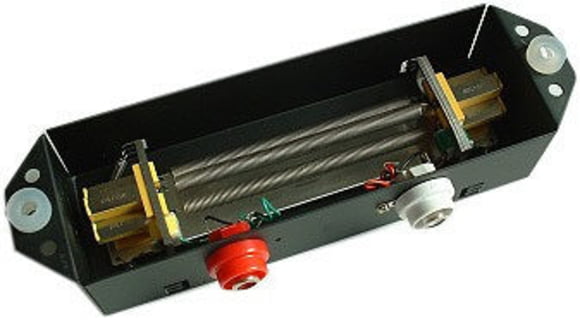3. Classic Reverb Devices
The sound that many musicians, particularly guitarists, think of as reverb is in fact not natural reverb produced in a room or hall, but the sound of a spring or plate reverb device:
Spring Reverb
This device originated with guitar amplifiers of the 50s, and is still commonplace today. A spring reverb is a simple device with an electrical transducer at one end, a pickup at the other end and a number of springs in between. The input signal is converted into a physical impulse by the transducer at one end of the springs - this produces motion in the springs which is converted back into an electrical signal by the pickup. The elasticity of the springs results in a complex pattern of motion which persists for some time, and this gives a sound somewhat akin to natural reverb. This can be tuned to some extent by varying the number of springs and using springs of different tensions. The signal from the reverb unit is then mixed with the dry guitar signal, usually by means of a rotary mix control.
Spring reverb tends to emphasise treble frequencies, though the result is rarely harsh. The best spring reverbs have a warm, organic sound particularly beloved of blues guitarists. Also, a sharp, slightly alarming sound reminiscent of vintage sci-fi effects can be produced by moving or hitting an amp fitted with spring reverb this is one aspect that has yet to be emulated digitally!
Plate
This is a very similar to spring reverb, but uses a metal plate or sheet instead of springs. The result is usually rather smoother. Plate reverb units are very bulky and were designed for studio use. Plate reverb is a tried and tested effect, particularly on vocals.
Chamber/Tunnel
Before the advent of digital processing, Echo chambers represented the only way of adding any kind of real sounding reverb. The idea is to capture the reverberation of a real physical space by playing and recapturing sound in that space. The space in question may of course simply be the studios live room rather than a dedicated reverb chamber - the legendary British producer Joe Meeks place in studio folklore is partly associated with his technique of using the studio bathroom for this.
Dedicated echo chambers are nowadays the esoteric (and expensive) preserve of a few high-end studios. In order to compete with the audio quality of digital processors, they must be very well sound-proofed. To this end, a few purpose-built studio complexes feature purpose-built underground reverb tunnels.
The operation of any reverb tunnel or chamber is a straightforward matter dry sound is played from a speaker and picked up by a microphone placed some distance away. The length of reverb achieved depends on the size of chamber, the building materials and coverings, and the placement of both the speaker and microphone. For maximum flexibility, it makes sense to capture as much wet reverb sound (as opposed to the dry sound direct from the speaker), as ultimately the wet/dry balance can be controlled in the mix.
Hall/Ambience
Its easy to overlook the fact that many great recordings have simply been made in venues with pleasant natural reverb, such as concert halls and churches. The ethos behind much classical recording involves capturing an accurate stereo image of an ensemble, including the sound of the venue. When accurate stereo imaging is the priority, a simple arrangement of two or three microphones is usually used - this permanently captures any reverb along with the direct sound. The opposite approach, for maximum mixing flexibility, involves multiple close microphones capturing an essentially dry sound. To add reverb to this, ambient 'microphones may be placed at some distance from the ensemble (often pointing away) and recorded separately.
A great sounding concert hall or recording space may of course be used as a reverb chamber, as in the case of the strings on The Beatles Eleanor Rigby, which were originally recorded fairly dry in Abbey Road Studio Two. When re-mixing the track some thirty years later, George Martin used the larger live room of Studio One to add reverb.



